Mastering Quack Grass: Effective Elimination Strategies
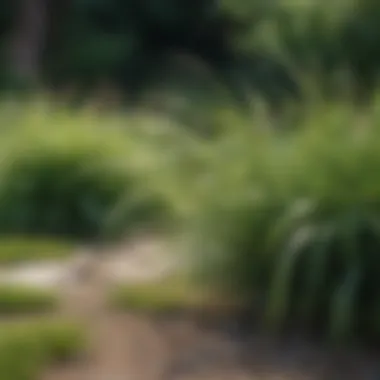

Intro
Quack grass, recognized by its vigorous growth patterns and tenacity, is a perennial weed that challenges many gardeners and landscapers. Its capacity to thrive in various conditions makes effective removal crucial for maintaining a healthy garden and lawn. Understanding effective strategies for eradicating quack grass is not just beneficial; it is essential for creating aesthetically pleasing outdoor spaces.
This article delves into a comprehensive exploration of various methodologies to seamlessly manage and eliminate quack grass. From identifying this invasive weed to culturally sensitive gardening practices, careful application of chemical solutions, and environmentally friendly options, the guide is segmented to cater to diverse gardening styles and individual preferences. Whether seeking immediate relief from an infestation or looking to implement long-term strategies, informed choices are central to the process.
The insights offered in this article aim at empowering readers, providing them with the knowledge base required for effective quack grass management. Each method discussed will elucidate important details and actionable steps, ensuring clarity and applicability in diverse gardening contexts.
Key Insights and Trends
When dealing with quack grass, awareness of current trends in gardening practices is vital.
- Current Trends in Gardening: Many modern gardeners are leaning towards organic practices, promoting healthy soil, and ecological balance. This shift in focus might include using mulching techniques or fostering beneficial plants that can outcompete quack grass for resources.
- Popular Gardening Techniques of the Season: Techniques like solarization, where plastic sheeting captures sunlight to heat the soil, can effectively kill weed roots. Another emerging trend is the use of native plant species, which are less susceptible to invasion by aggressive weeds, allowing homeowners to cultivate resilient ecosystems.
Practical Tips and How-To Guides
For practical assistance, below are detailed tips and step-by-step guides to address quack grass effectively:
- Identifying Quack Grass: To effectively manage this weed, proper identification is crucial. Quack grass has a narrower blade compared to most grasses and features a distinct creeping growth pattern.
- Cultural Practices: This includes:
- Chemical Solutions: If cultural practices fail, chemical options might be necessary. Always consider selective herbicides like glyphosate that specifically target grasses while minimizing harm to ornamental plants. Always adhere to safety protocols while handling chemicals.
- Sustainable Options: Introducing biocontrol methods is an effective long-term strategy. These can include:
- Regular mowing to weaken the grass' growth. Aim to mow at higher settings to avoid cutting desirable grasses too short.
- Increasing lawn density through overseeding can help outcompete quack grass.
- Maintaining a healthy soil structure improves drainage and enhances the health of desirable plants.
- Encouraging beneficial insects that feed on weed seeds.
- Implementing a diversified planting strategy to promote competition.
Effective management of quack grass begins with knowledge and proactive strategies. Addressing the issue is not just about removal; understanding the ecosystem is essential for lasting results.
By equipping oneself with the right approaches and tools to handle this invasive weed, homeowners can pave the way for healthier and more vibrant garden spaces.
Understanding Quack Grass
Understanding quack grass is essential for effective management strategies. This perennial weed can quickly outcompete other plants, leading to reduced aesthetics and health in gardens and lawns. Knowing its traits and behaviors can help homeowners and gardeners formulate appropriate control measures. Misidentifying it could result in ineffective treatments, wasting both time and resources. Hence, a thorough understanding lays the groundwork for further strategies to eliminate or control it.
Defining Quack Grass
Quack grass, scientifically known as Elymus repens, is a highly adaptable perennial weed. It features long, slender leaves and a creeping growth habit that enables it to spread quickly through rhizomes. This underground network allows it to thrive in various environments, often outcompeting desirable plants. As a result, defining quack grass correctly is the first step in addressing it effectively.
Identifying Quack Grass
Proper identification is crucial to managing quack grass effectively. This section discusses identifying the weed through its physical characteristics, growth patterns, and seasonal behavior.
Physical Characteristics
Quack grass typically has narrow, long leaves that display a finely serrated edge. The leaf blades can reach lengths of up to 12 inches and have a distinctive green hue. One key characteristic is its root system, which consists of thick rhizomes. These rhizomes not only store energy but also facilitate reproduction. Understanding these physical traits helps in recognizing the weed in its early stages.
Advantages: Recognizing quack grass early can prevent it from taking over a garden or lawn. Homeowners can act swiftly to mitigate its spread.
Growth Patterns
This weed exhibits aggressive growth, often forming dense mats that can suffocate other plants. Quack grass spreads invasively, reaching out from its initial planting site through creeping rhizomes. This pattern can create a tangled mess in gardens, making it difficult for desired plants to flourish. Homeowners should be aware that once established, quack grass is often difficult to eradicate.
Disadvantages: Its invasive nature poses a significant challenge. Without proper control measures, quack grass can dominate garden space, reducing biodiversity and overall health.
Seasonal Behavior
Quack grass demonstrates seasonal behavior that varies with climate. It typically emerges in spring, becoming most vigorous in summer. This weed can enter dormancy during extreme cold or drought but often resurfaces when conditions improve. Understanding its seasonal cycle is important for timing control measures effectively.
Key Characteristic: The ability to adapt to seasonal changes can make quack grass more challenging to manage, as it may seem to disappear, only to reappear stronger.
Impacts of Quack Grass
Quack grass has become a prevalent concern for those engaged in gardening and landscaping. Its capacity to invade desired plant spaces significantly disrupts the ecosystem of your garden. Understanding the impact of quack grass is crucial for developing effective management strategies. It not only threatens the growth of preferred flora but can also lead to broader soil health issues.
Effects on Desired Plants
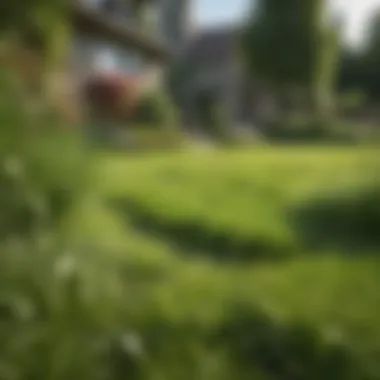

The presence of quack grass poses direct competition against desired plants for essential resources. Quack grass develops a robust root system that spreads horizontally, enabling it to encroach upon the root zones of ornamental plants and crops. This competition is detrimental to the health and growth rate of desired plants, as they may struggle to gather enough nutrients, water, and sunlight.
Secondarily, quack grass can alter the microclimate of the garden bed. Its tall, dense blades can overshadow smaller plants, impacting their ability to photosynthesize effectively. Consequently, plants that are meant to flourish may instead dwindle under the shadow of this invasive weed.
Overall, the effects of quack grass extend into the very foundation of the garden ecosystem. It reduces the biodiversity of plant life, which is essential for balanced ecosystem health.
Impact on Soil Health
Beyond its competition with plants, quack grass severely impacts soil health. It is known to disrupt the nutrient balance in the soil. As quack grass proliferates, it can draw essential minerals and nutrients away from the soil, leading to depletion. This depletion can have a ripple effect on all vegetation, not just those directly adjacent to the quack.
Furthermore, quack grass contributes to soil erosion. This is particularly relevant in cases where it is removed or tilled prematurely. The soil becomes vulnerable without the stabilizing roots of established plants, leading to potential loss of topsoil. This problem emphasizes the necessity of a careful approach to weed management.
In summary, the impacts of quack grass are multifaceted. They extend to the health of desired plants and the overall quality of the soil. Recognizing these consequences is an essential first step in implementing effective management strategies.
Cultural Practices for Control
Cultural practices for control are essential facets in the fight against quack grass. By focusing on the overall health and resilience of the desired plants, these practices can limit the establishment and spread of this invasive weed. Adopting efficient techniques in lawn care, crop rotation, and other management practices can create an environment less conducive to quack grass proliferation.
Proper Lawn Care Techniques
Optimal Mowing Heights
Mowing height significantly impacts lawn health. Setting the mower blades at the correct height promotes stronger grass, which can outcompete quack grass. Research suggests that keeping grass at a height of 3 inches helps maintain root health. This means the grass has a better chance to establish itself and reduce the sunlight reaching quack grass. Additionally, higher mowing can discourage quack grass because it prefers sunnier environments. However, mowing too high risks the development of other weeds, so it's crucial to find the right balance.
Regular Watering Practices
Watering is fundamental to a healthy lawn. Regular watering helps keep desired grass flourishing, while stressing quack grass. The key characteristic of effective watering is consistency. Watering deeply and infrequently encourages deep root growth. This, in turn, makes the lawn more resilient during dry periods. A unique feature of this method is its ability to restrict shallow-rooted weeds like quack grass. On the downside, overwatering may create a conducive environment for other weed types. Therefore, understanding the local climate and soil type is vital.
Nutrient Management
Nutrient management plays a critical role in lawn health. Applying the correct fertilizers at the right time is essential. This helps lawn plants thrive and reduces the likelihood of quack grass invading. A notable characteristic of this strategy is the focus on soil testing. It helps homeowners understand their specific lawn's needs. For example, too much nitrogen can actually boost quack grass growth, while balanced nutrients can inhibit it. While providing nutrients, one must also consider potential water runoff or pollution, ensuring eco-friendly practices.
Crop Rotation
Crop rotation is another strategic measure that can effectively disrupt the life cycle of quack grass. By changing crops in a particular area, gardeners can prevent quack grass from establishing itself. This practice can alter nutrient demands and growth conditions, making it difficult for quack grass to thrive. Certain crops can address nutrient depletion, ensuring the soil is less appealing to unwanted weeds. However, one must plan the rotation carefully. The success of crop rotation depends on timing and types of crops chosen, meaning it is essential to educate oneself on compatible plants.
> "Cultural practices are proactive approaches that create healthy ecosystems, making it harder for quack grass to grow. By adjusting basic lawn care routines, you can foster resilience in your grass."
These cultural practices form the foundation of a robust garden management strategy against quack grass. By diligently applying proper lawn care techniques and considering crop rotation, gardeners can create an environment that naturally resists this invasive weed. Following these strategies does require commitment and adjustment, but they pave the way for a healthier lawn.
Mechanical Removal Methods
Mechanical removal of quack grass serves as an effective strategy in managing this persistent weed. This method relies on physical techniques that disrupt the growth and spread of quack grass. Using mechanical methods can contribute to a healthier garden by eliminating the weeds without introducing chemicals into the soil. It is both effective and necessary for homeowners who want to avoid the use of herbicides.
When dealing with quack grass, using mechanical methods can provide a quick sense of control over the situation. It can also be beneficial in maintaining soil integrity. This is important because chemical solutions can sometimes harm beneficial microbes in the soil, which are essential for plant health. Therefore, these mechanical methods become relevant, especially for gardeners focused on sustainable practices.
Manual Pulling Techniques
Manual pulling is perhaps the most straightforward approach. Homeowners can effectively remove quack grass by pulling it out by hand. For this method to be effective, one must grasp the base of the plant and pull it out slowly. It is crucial to ensure that the entire root system is removed; otherwise, the plant may grow back.
Timing is critical. The best time to pull quack grass is when the soil is moist, which makes it easier to get rid of the roots. Wearing gloves can help prevent skin irritation and provide a better grip. This method is labor-intensive but works well in small areas or gardens.
"Regular manual pulling can significantly reduce quack grass populations over time, provided it is done thoroughly and consistently."
Tilling
Tilling offers another mechanical approach, often considered when dealing with larger infestations of quack grass. This method involves using a tiller to break up the soil and cut through the roots of the grass. It's effective because it not only removes the plants above ground but also disturbs the root systems below the surface.
However, one should employ caution with this method. Over-tilling can harm beneficial organisms in the soil. It is recommended to till at a shallow depth to minimize disruption to the soil structure. Additionally, timing is essential; tilling should ideally be done when the soil is dry to prevent compaction.
Utilizing mechanical removal methods requires ongoing effort and attention. Manual pulling and tilling present a hands-on way to combat quack grass, contributing positively to garden maintenance. A combination of these methods can yield the best results, particularly if incorporated into a larger maintenance plan.
Chemical Solutions
Chemical solutions play a crucial role in addressing the persistent issue of quack grass. For many homeowners and gardeners, understanding when and how to use chemical interventions is vital for effective management. They offer a targeted approach that can significantly reduce the presence of quack grass, especially when other methods may fall short. However, these approaches require careful consideration of their strengths and potential drawbacks.
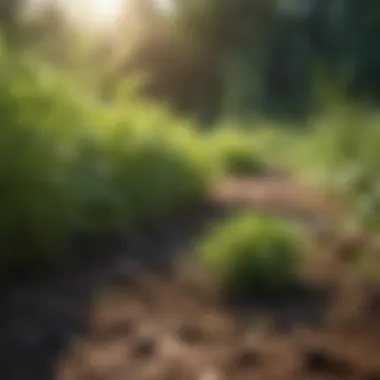
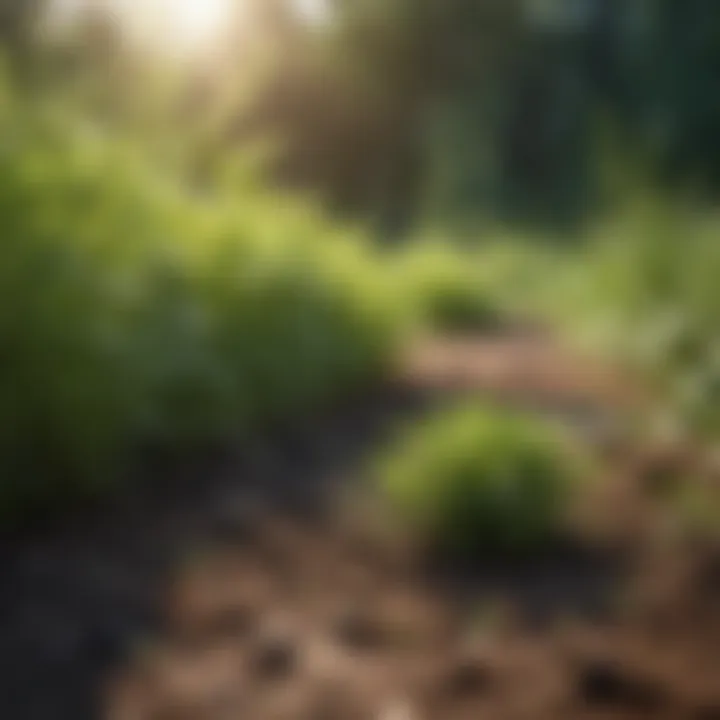
Chemicals can help maintain a healthy garden ecosystem, particularly by protecting desirable plants from competition with quack grass. The benefits of using these solutions can be substantial for those seeking quick and efficient results.
Herbicide Options
Selective Herbicides
Selective herbicides focus specifically on the weeds while leaving the desired plants unharmed. This feature is a primary advantage, allowing gardeners to maintain the health of their lawns and gardens without the risk of collateral damage.
One key characteristic of selective herbicides is their formulation, which often targets specific types of grasses, such as quack grass, without affecting other grass species or established plants. This quality makes them a popular choice among those wanting to eliminate quack grass while preserving the integrity of their lawns.
The unique feature of selective herbicides lies in their ability to disrupt the growth processes of vulnerable weeds. This advantage translates into effective weed suppression, allowing desired plants to thrive. That said, the reliance on such herbicides can pose disadvantages if not managed appropriately. For instance, improper application or overuse can lead to chemical build-up in the soil, affecting its health over time.
Non-Selective Herbicides
On the other hand, non-selective herbicides target all plant material they come into contact with. This aspect can be useful for completely clearing an area infested with quack grass, preparing it for replanting or renovation. This type of herbicide’s effectiveness in eliminating unwanted plants makes it a viable option for those with extensive quack grass issues.
The key characteristic of non-selective herbicides is their broad-spectrum killing ability. This quality can make them a beneficial choice when the objective is to clear large patches of grass or to start new planting beds. They are especially useful in gardens where the presence of desirable plants is minimal or absent.
However, a significant consideration with non-selective herbicides is their potential impact on surrounding flora. If applied carelessly, these chemicals can harm neighboring plants and disrupt local ecosystems. Moreover, gardeners must wait a specific duration before replanting, which can delay landscaping activities.
Application Techniques
The effectiveness of any herbicide largely depends on the application techniques employed. Getting the timing and method right can enhance the impact of the chemical solution. Key strategies include:
- Timing: Apply herbicides during the early growth stage of quack grass for maximum efficacy. This approach minimizes the energy of the plants to resist treatment.
- Weather Conditions: Choose a calm day for spraying to prevent drift. Avoid applying during windy or rainy conditions.
- Equipment: Use the correct applicator to ensure even coverage. A sprayer with adjustable nozzles can help target weeds effectively without affecting surrounding plants.
Ultimately, understanding and executing precise application techniques can significantly increase the success rate in eliminating quack grass, ensuring that chemical solutions serve their intended purpose efficiently.
Sustainable Approaches
Sustainable approaches to managing quack grass emphasize environmentally friendly methods that minimize harm to the ecosystem. These strategies are increasingly observed as integral in combating pervasive weeds like quack grass. Such approaches not only address immediate weed issues but also promote long-term soil health and biodiversity. By minimizing synthetic chemicals, sustainable practices contribute to a healthier garden and environment, aligning with the growing trends of eco-conscious gardening.
Organic Control Methods
Vinegar Solutions
Vinegar solutions represent a popular organic method for managing quack grass. The main aspect of this approach hinges on the acetic acid found in vinegar, which acts as a natural herbicide. This characteristic makes vinegar an appealing choice in the quest for non-toxic weed management. The advantage of using vinegar lies in its easy accessibility and affordability; most household vinegar contains about 5% acetic acid, making it relatively safe for most plants in controlled situations.
However, there are limitations to this solution. Vinegar is effective primarily on young plants and weaker stems. It may not completely eradicate established quack grass, but it can reduce its spread. Proper application is crucial. For optimal results, spraying on sunny days can enhance efficacy, as sunlight increases the herbicidal effects of acetic acid.
Essential Oils
Essential oils also play a significant role in organic weed control. The efficacy of certain oils stems from their natural properties. For example, clove oil and peppermint oil are known for damaging plant cells when applied directly to foliage. The key characteristic of essential oils is their concentrated nature, which can serve as a potent deterrent for quack grass when used correctly. These oils contribute to a more holistic method of weeding that respects the surrounding flora.
The unique feature of essential oils is their multifaceted benefits. Not only do they target weed growth, but they also possess antibacterial and antifungal properties which can enhance soil health. Nevertheless, using essential oils requires precise handling, as their concentrated form can harm desirable plants if improperly applied. Users should also be wary of potential allergenic reactions from certain compounds, making it essential to conduct patch tests prior to widespread use.
Encouraging Natural Predators
Natural predators can serve as a valuable ally in quack grass management. By promoting an ecosystem where beneficial insects thrive, gardeners can benefit from these creatures' natural weed-fighting tendencies. For example, certain insect populations can help control weeds by preying on seeds or juvenile plants. Implementing strategies such as planting native flora can help attract these beneficial species. This organic approach also contributes to a vibrant garden ecosystem. The dual effect of pest management and weed control reinforces the sustainability of gardening practices.
"Implementing sustainable approaches not only addresses weed problems effectively but also supports the overall health of your garden ecosystem."
In summary, using sustainable methods to combat quack grass involves a multifaceted approach that incorporates organic control methods and encourages natural predators. By adopting these strategies, gardeners can achieve a healthier garden environment while effectively managing quack grass.
Preventive Measures
Preventive measures are crucial when addressing the challenge posed by quack grass. By focusing on these strategies, homeowners can reduce the likelihood of quack grass becoming established in their gardens and lawns. Not only do these practices protect desired plants, but they also promote overall soil health. Quack grass thrives when specific conditions are met; thus, maintaining certain factors in the garden can create an unfavorable environment for its growth.
Key elements of successful preventive measures include choosing the right plants, implementing proper irrigation techniques, and employing effective soil management.
Benefits of Preventive Measures:
- Minimizes the risk of infestations
- Supports healthier plant life
- Encourages the development of robust soil.
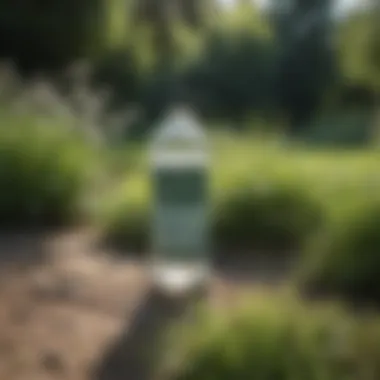

When establishing a gardening plan, one must consider local conditions like climate and soil type. Tailoring your preventive strategies to these aspects can lead to notable improvements.
Mulching Techniques
Mulching presents an effective way to suppress quack grass. By covering the soil, mulch acts as a barrier that limits sunlight, which stifles quack grass growth. This practice also retains soil moisture, maintaining a favorable environment for your plants while making it difficult for undesirable weeds to thrive.
Choosing the right mulching material:
- Bark chips: Perfect for decorative gardens.
- Straw: Good for vegetable gardens.
- Rubber mulch: Long-lasting but may not allow moisture penetration.
It is important to apply mulch to the recommended thickness, generally between 2 to 4 inches. This thickness helps prevent any light from reaching quack grass seeds, reducing their chance of germination. Regularly monitor the state of your mulch and replenish as necessary.
Maintaining Lawn Density
A dense lawn can serve as a natural defense against quack grass. When grass is thick and healthy, it outcompetes quack grass for light, water, and nutrients. Maintaining proper lawn density requires a comprehensive approach, from the initial plant selection to ongoing lawn care practices.
Recommended practices to boost lawn density:
- Overseeding: Introduce high-quality grass seeds to fill bare spots.
- Proper fertilization: Apply nutrients based on soil tests to promote vigorous growth.
- Adequate watering: Ensure roots receive sufficient moisture without encouraging shallow growth vicinity that quack grass could exploit.
By focusing on lawn density, homeowners can create an environment less conducive to quack grass proliferation. Engaging in regular loom inspections and adjusting care routines as needed is vital to maintain the desired lawn appearance.
Monitoring and Maintenance
Monitoring and maintenance are critical components in effectively managing quack grass. Keeping an eye on your garden or lawn allows you to detect problems before they escalate. This proactive approach can save time, money, and effort in the long run. Failing to monitor your space can lead to unexpected outbreaks of quack grass, which can become challenging to control once established.
Regular monitoring allows for timely interventions. This could mean noticing when quack grass starts to reappear after treatment or when its growth becomes more aggressive during specific seasons. Understanding growth patterns is vital; conducting regular inspections helps you to stay one step ahead.
Additionally, consistent maintenance contributes to overall soil health and promotes the well-being of desired plants. A well-maintained garden encourages robust plant growth, which can outcompete quack grass naturally.
Regular Inspections
Regular inspections should be a part of your lawn care routine. This practice involves looking for signs of quack grass and other weeds as you tend to your garden. Check for the distinctive characteristics of quack grass, such as its upright stalks and grass-like blades. Early identification can lead to more effective removal strategies.
During inspections, you can also assess the condition of your desired plants. This is essential because healthy plants can prevent weed encroachment. Inspect the soil as well, as compacted or nutrient-deficient soil can encourage quack grass growth.
Here are some steps to conduct regular inspections effectively:
- Set a schedule: Choose a consistent time each week or month to review your garden.
- Look for changes: Note any differences in plant health or new weed growth.
- Take notes: Document your findings for future reference; this can help refine your strategies.
- Act immediately: If you spot quack grass, consider immediate removal or application of appropriate herbicides if necessary.
Adjusting Strategies
After conducting regular inspections, it may become necessary to adjust your strategies for controlling quack grass. Conditions can change—whether that’s due to seasonal effects, soil health, or growth of desirable plants. Flexibility is key to maintaining a quack grass-free environment.
When examining your approach, consider the following elements:
- Effectiveness: Are your current strategies yielding results? If quack grass persists, it may be time for a change.
- Changes in the environment: Weather patterns, soil conditions, and plant health can all affect the efficacy of your methods. Adapt your strategies accordingly.
- Feedback loops: Use the data collected from inspections to inform your decisions. If certain tactics worked well last year, they may do so again, or conditions may dictate a different approach.
In sum, a routine of monitoring your garden and maintaining sound practices can lead to effective control of quack grass. Staying aware of changes and adapting your strategies will contribute greatly to long-term success.
The End
The conclusion of this article on quack grass is not just a summary but an important culmination of effective strategies that homeowners, gardeners, and landscapers can use. Understanding how to effectively eliminate quack grass can greatly enhance the health and aesthetics of any lawn or garden. The methods discussed are tailored to fit various situations, allowing for flexible approaches based on individual needs.
Recap of Effective Strategies
In reviewing the effective strategies, we uncovered several key points:
- Identification Methods: Knowing how to identify quack grass is fundamental. Recognizing its physical characteristics, growth patterns, and seasonal behavior can help determine the most appropriate control measures.
- Cultural Practices: Implementing proper lawn care techniques, such as optimal mowing heights and nutrient management, can strengthen desired plants and minimize the chance for quack grass to thrive. Crop rotation further enriches soil health and discourages persistent growth.
- Mechanical Removal: Manual pulling and tilling of the soil are some effective ways to remove quack grass physically. For best results, these methods should be done during periods when the soil is moist.
- Chemical Solutions: Selective and non-selective herbicides can provide a quick fix but should be used judiciously. It's essential to follow the application techniques carefully to prevent damage to desirable plants.
- Sustainable Approaches: Organic solutions, including vinegar treatments and the use of essential oils, offer environmentally friendly alternatives. Encouraging natural predators is another strategy that contributes to a balanced ecosystem, which can naturally suppress quack grass.
- Preventive Measures: Regular mulching and maintaining high lawn density are effective for preventing the introduction and spread of quack grass.
- Monitoring and Maintenance: Regular inspections and adjusting strategies based on observations ensure that the desired outcomes occur and that the control measures remain effective over time.
Practically, combining these methods can yield the best results. A multi-faceted approach not only tackles the current issue but also sets the stage for long-term management of quack grass.
Encouragement for Sustainable Practices
As we conclude, it's vital to emphasize the importance of sustainable practices in managing quack grass. By choosing organic methods over chemical ones when possible, homeowners can promote a healthy garden environment. Sustainable practices protect biodiversity, enhance soil quality, and ensure the safety of pets and children.
Additionally, fostering a natural ecosystem allows for self-regulation, where natural predators can decrease the quack grass population without human intervention.
The adoption of these practices can lead to more resilient gardens that are better equipped to handle the challenges posed by invasive weeds like quack grass. Hence, embracing sustainable strategies not only benefits individual gardens but contributes positively to the broader environment.
Quack grass removal is undoubtedly a challenge, but with informed choices and sustainable methods, it becomes an achievable task for every gardener.



